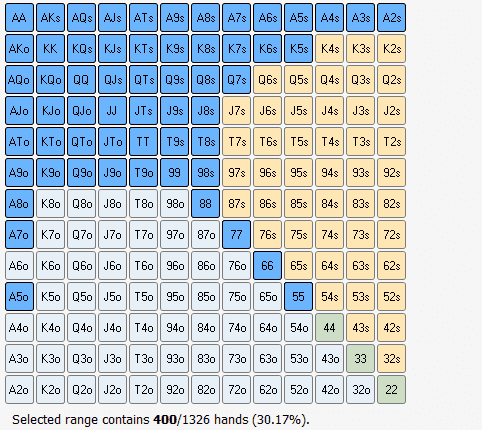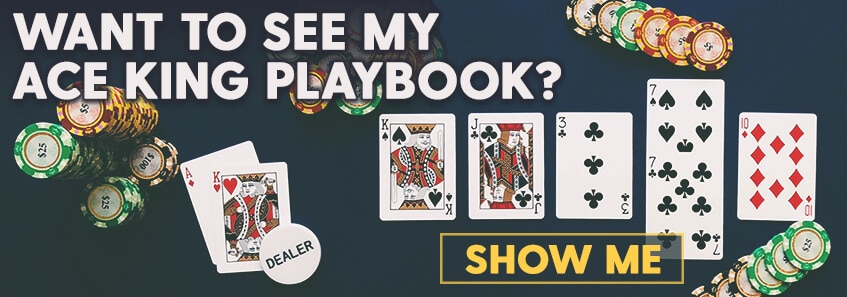Adam says, “I was playing a 20NL and got pocket aces under the gun playing 6 max. I have $19.10. I had a bad beat in the beginning of the game and got down to around 13 bucks and then won it back playing some good poker. Anyways, I got two callers, MP and a cutoff, cutoff is a guy I’d been pushing around who had a VPIP of 50%.” Here’s the hand:
Okay, so Adam just gets these two callers, goes three way to the flop, decides to continuation bet, and I like that we’re continuation betting, I just think that the size is a little bit small, especially with someone who has a 50% VPIP, I’d really like to see this larger, strictly for value. This is the kind of board where any jack X is going to be very inelastic, most pocket players are usually going to peel off at least one street, when their hand is like 76 and 65 and 43, they definitely will continue for at least one bet, so I’d really like to see this bet be a little bit larger, probably something in the three-quarter, so like a 1.50, 1.55 type ballpark. Hero ends up getting just the call from cutoff, goes to the turn, Hero decides to check, and then ends up going for a check raise.
At this point, Adam says, “I want to pretend like I’m trying to outplay him, so I quickly hit the pot button and raise to 13.65.”
Now in my opinion, taking that thought process of trying to outplay someone or them thinking that you’re trying to outplay them necessitates a thought process from your opponent. Someone who is playing with a 50% VPIP probably doesn’t have much of a thought process beyond just their cards and how their cards hit the board. It’s not like he’s probably going to be thinking about ranges, he’s not thinking about people trying to outplay him most likely and even if he did, he wouldn’t know what that outplaying looked like.
I don’t really think that that’s going to be a good thought process here and in my opinion, I think the check raise is likely probably a wasted play, simply because by check raising, I think we’re going to lose value from hands we could’ve gotten one, if not two streets of value from, things like jack X. I think if we check raise here, he’s going to consider folding them. Sure, if he has queen X, that’s all well and good, but with aces, we block out ace/queen, which limits him to kind of like a king/queen, maybe queen/ten float on the flop, but beyond that, there’s probably not a ton of queen X stuff other than of course queen/jack, which now beats us.
Then we’re in a situation where if we check raise, we’re probably going to blow out six X, pocket nines, all that kind of stuff. I see the check raise actually limiting the amount of value we can make here, whereas if we had just bet the turn ourselves, going back a couple of ticks, you bet the turn for something like $3, you bet the river for something like 6 or 7, then you could possibly get those calls because this is someone who looks to be passive, their pre-flop play was passive, their flop call was passive, they have a 50% VPIP, I’m assuming there’s a large gap in the VPIP PFR, which means I assume he’s going to make more calling mistakes. I would rather just stay in a value-betting mindset, bet turn, bet river, and go forward from there.
I don’t really see the check raise here being the best play. I see us blowing out all the hands we could’ve gotten value from another way and really only putting ourselves in against hands that are going to annihilate us. In this exact situation, he shoves, obviously we’re not going to fold at this point getting such a sick price, but I’m really not shocked to see that we end up running into a pocket three’s, but I wouldn’t have been surprised to run into pocket sixes or queen/jack or any of that kind of stuff. I think that by taking this line, we put ourselves against the toppest part of his range and end up hurting ourselves.
Again, I think how we just bet turned and almost kind of more of a bet fold or at least considering a bet fold line against someone who is passive. That’s a pretty default line of mine against a passive fish, is just to kind of be in a bet/fold mode with my over pairs and my top pairs because they tend not to raise unless they have two pair plus, but they tend to call wide, so it makes bet folding a very, very valid line.
So to wrap up the hand, Adam said, “Did I do something really wrong or just get unlucky? Because I had 86% equity in the turn, giving him a 30% calling range in Equilab. I really want to know because I will usually make a steady profit when playing but I’ll lose a big stack in a stupid way, usually when tilted, but I’m working on it.”

There’s essentially two main points I want to make here. Yes, I do think you made a mistake in this hand. I think the check raise given the rationale that you gave was not best and I think that just betting the turn yourself would’ve been better.
The other thing I want to talk about is that 86% equity that you quoted. You said that’s against a 30% calling range, which means that you essentially think that he’s going to be calling a wide range pre-flop, he’s going to be calling a ton of those hands on the flop and that he’s going to be betting a ton of those hands in the turn. Even if he does that, even if he does that with a ton of hands and you really do have 86% equity against his turn betting range, it does not mean that you’re going to have 86% equity against his turn stack-off range because he’s probably not going to be stacking off all those hands that you have incredible equity against, things like 7/5 and ace/4 and all that kind of junk. He’s probably not going to be stacking off with all of those.
So when his stack-off range starts to look like two pairs, top pairs and sets, well, then all of a sudden your equity is going to look significantly different and that’s definitely something that you want to keep in mind. It’s important that when you’re working this off the table and you’re running things through Equilab that you understand what your range looks like and how much equity you have, but you also have to understand what different ranges will look like. When you make a check raise on the turn, you’re probably not going to have 86% equity when you get it all in unless you think that he’s really taking a ton of top pairs and single pairs too far.
I think overall, you’re going to be running into a much stronger range, which is going to have you with less than 86% equity by a large margin.
Definitely keep that in mind. It’s important to run the math and run the equity through Equilab, but you need to make sure that you’re running the equity from and against the correct ranges. If you’re running it against a betting range that’s different than the range that he would necessarily give your check raise action with. Definitely keep that in mind when you’re working things off the table.

